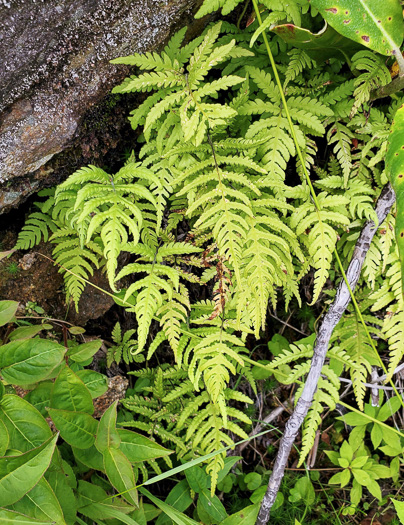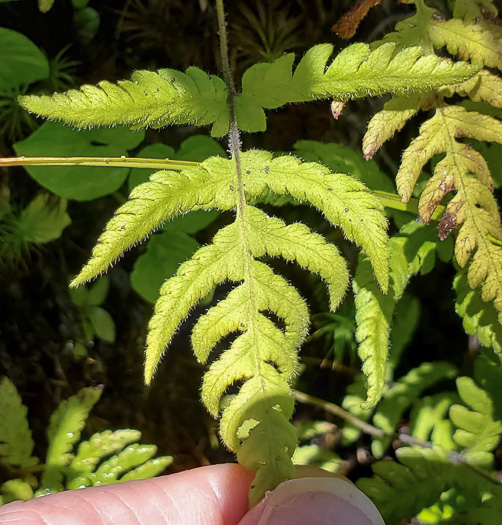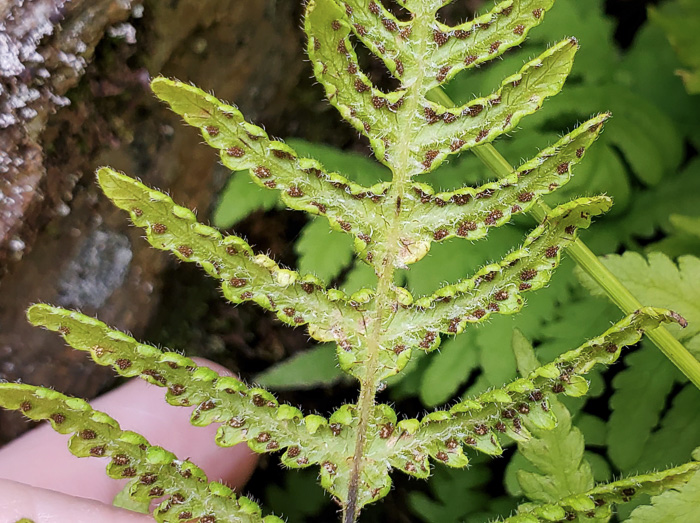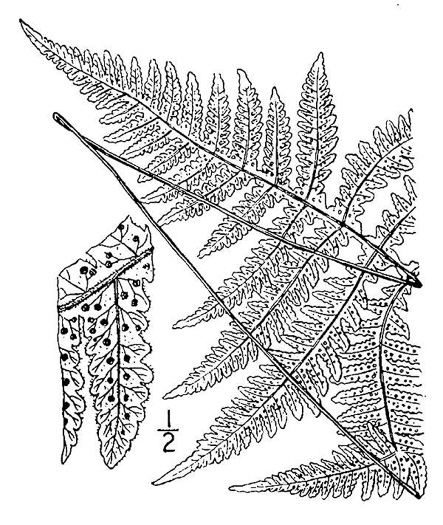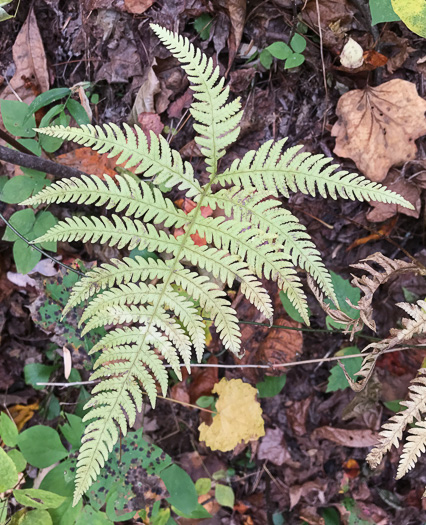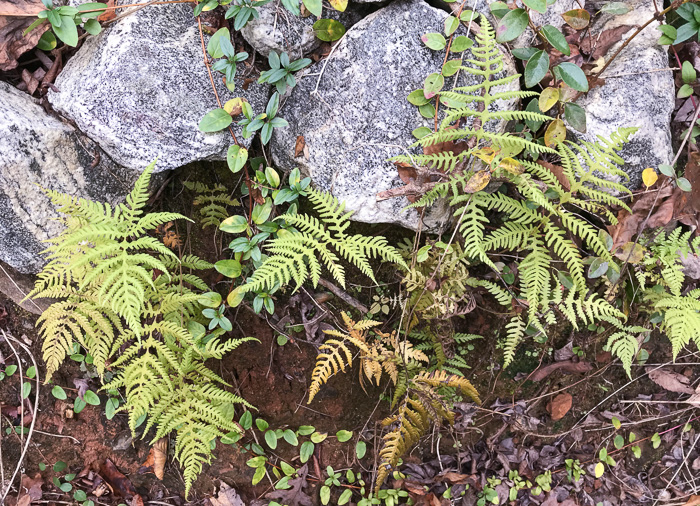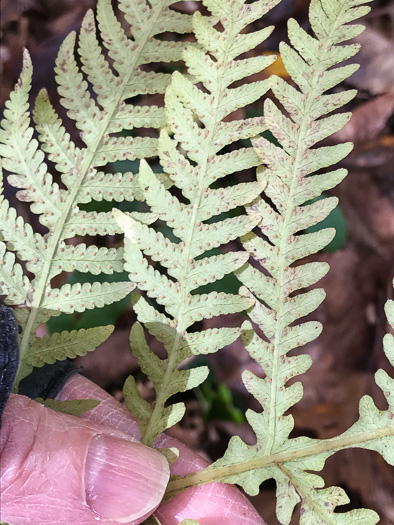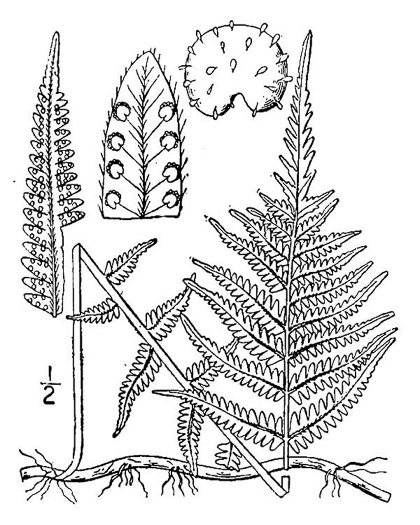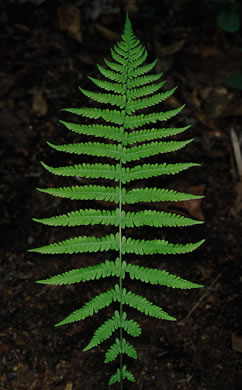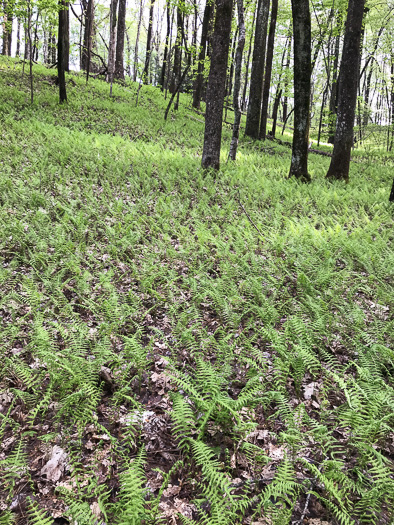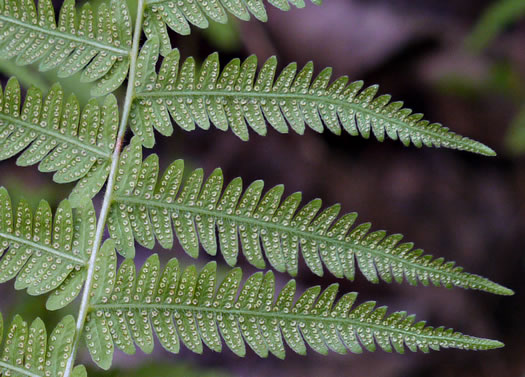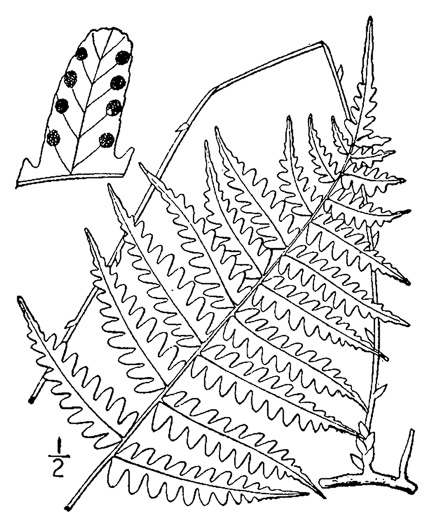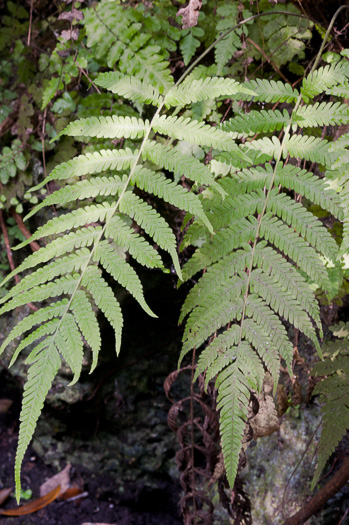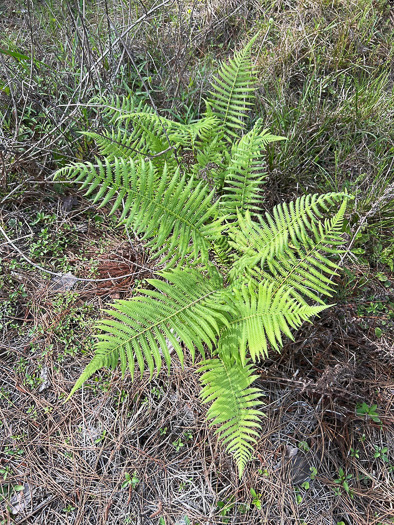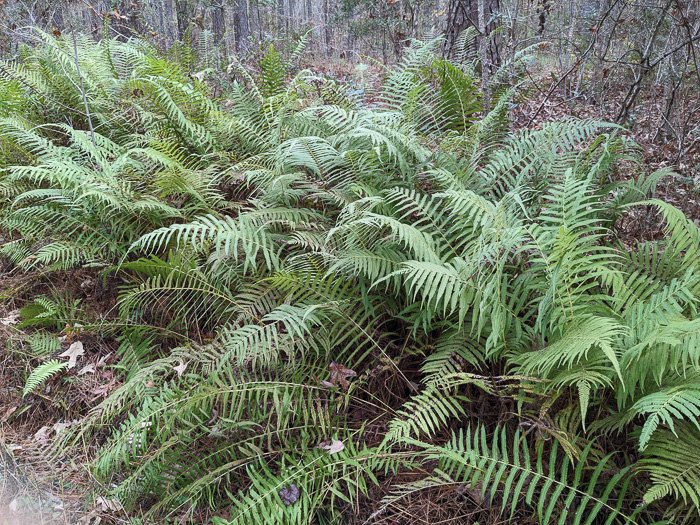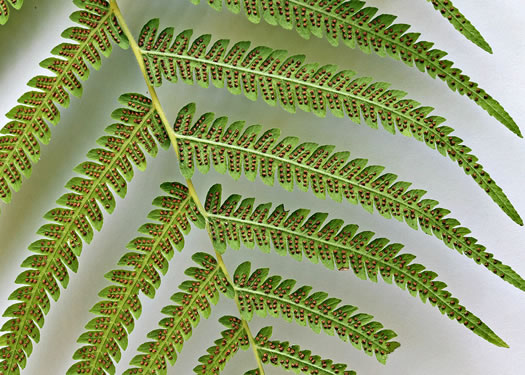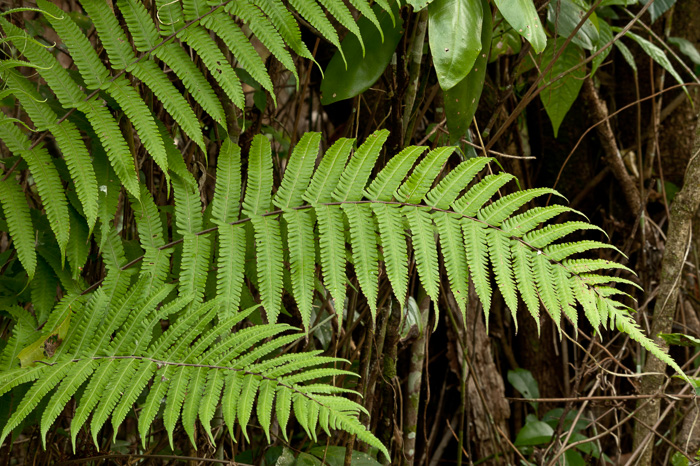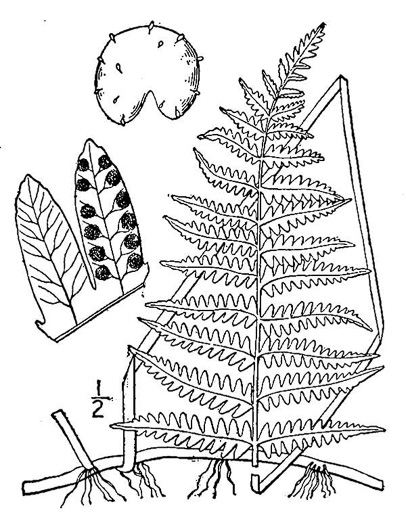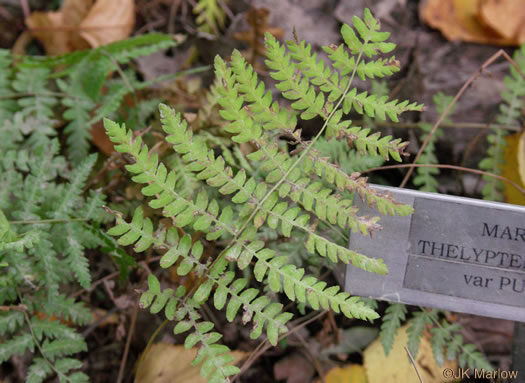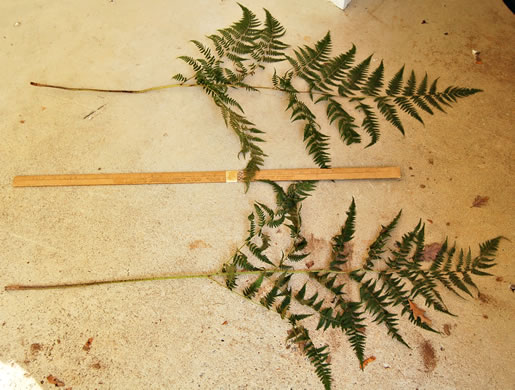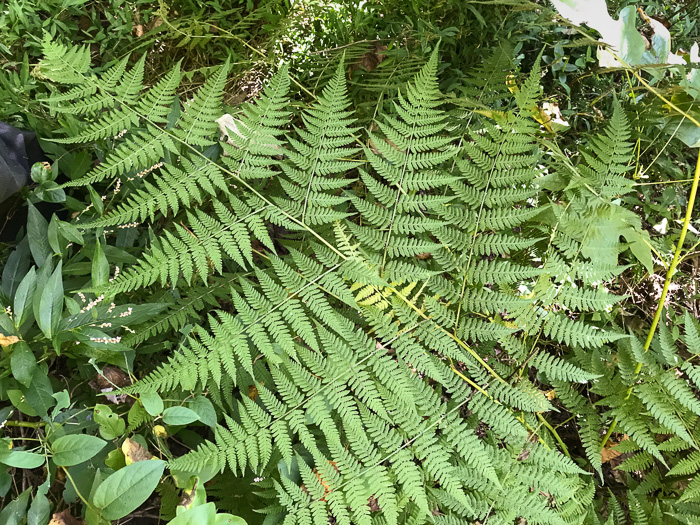Hovering over an image will enlarge it and point out features (works better on desktop than on mobile).
![]() A camera indicates there are pictures.
A camera indicates there are pictures.
![]() A speaker indicates that a botanical name is pronounced.
A speaker indicates that a botanical name is pronounced.
![]() A plus sign after a Latin name indicates that the species is further divided into varieties or subspecies.
A plus sign after a Latin name indicates that the species is further divided into varieties or subspecies.
Most habitat and range descriptions were obtained from Weakley's Flora.
Your search found 10 taxa in the family Thelypteridaceae, Marsh fern family, as understood by Weakley's Flora.

![]() Common Name:
Northern Beech Fern
Common Name:
Northern Beech Fern
Weakley's Flora: (4/24/22) Phegopteris connectilis FAMILY: Thelypteridaceae
INCLUDED WITHIN PLANTS National Database: Phegopteris connectilis FAMILY: Thelypteridaceae
INCLUDED WITHIN Vascular Flora of the Carolinas (Radford, Ahles, & Bell, 1968): Thelypteris phegopteris 011-06-001 FAMILY: Aspidiaceae
Habitat: Moist cliffs where wet by spray from waterfalls (at medium elevations), also on high elevation cliffs wet by seepage and in spruce-fir forests, northward in cool ravines and on swamp borders. Most of the occurrences in NC are at waterfalls in the escarpment gorges of Transylvania, Macon, and Jackson counties, near Highlands
Rare
Native to North Carolina

![]()
![]() Common Name:
Broad Beech Fern
Common Name:
Broad Beech Fern
Weakley's Flora: (4/24/22) Phegopteris hexagonoptera FAMILY: Thelypteridaceae
SYNONYMOUS WITH PLANTS National Database: Phegopteris hexagonoptera FAMILY: Thelypteridaceae
SYNONYMOUS WITH Vascular Flora of the Carolinas (Radford, Ahles, & Bell, 1968): Thelypteris hexagonoptera 011-06-002 FAMILY: Aspidiaceae
Habitat: Mesic to submesic hardwood forests
Common (uncommon in Coastal Plain)
Native to the Carolinas & Georgia

![]()
![]() Common Name:
New York Fern
Common Name:
New York Fern
Weakley's Flora: (4/14/23) Amauropelta noveboracensis FAMILY: Thelypteridaceae
SYNONYMOUS WITH PLANTS National Database: Thelypteris noveboracensis FAMILY: Thelypteridaceae
SYNONYMOUS WITH Vascular Flora of the Carolinas (Radford, Ahles, & Bell, 1968): Thelypteris noveboracensis 011-06-003 FAMILY: Aspidiaceae
Habitat: Mesic forests, bottomland forests, bogs, submesic forests
Common (uncommon to rare in Coastal Plain)
Native to the Carolinas & Georgia

Common Name: Bog Fern, Massachusetts Fern
Weakley's Flora: (4/24/22) Coryphopteris simulata FAMILY: Thelypteridaceae
SYNONYMOUS WITH PLANTS National Database: Thelypteris simulata FAMILY: Thelypteridaceae
Habitat: In NC and WV in acid peat bogs at about 1000 meters in elevation, in DE, NJ, and VA in acid seepage swamps in the Coastal Plain
Rare
Native to North Carolina

![]()
![]() Common Name:
Kunth's Maiden-fern, Southern Shield-fern, Southern Woodfern
Common Name:
Kunth's Maiden-fern, Southern Shield-fern, Southern Woodfern
Weakley's Flora: (4/13/22) Pelazoneuron kunthii FAMILY: Thelypteridaceae
SYNONYMOUS WITH PLANTS National Database: Thelypteris kunthii FAMILY: Thelypteridaceae
SYNONYMOUS WITH Vascular Flora of the Carolinas (Radford, Ahles, & Bell, 1968): Thelypteris kunthii 011-06-004 FAMILY: Aspidiaceae
Habitat: Coquina limestone (‘marl’) outcrops, calcareous bluffs and sinkhole slopes, also adventive on and around coquina limestone (marl) riprap around small bridges and ditches and in suburban forests
Common in Coastal Plain of GA & SC (rare elsewhere in GA-NC-SC)
Native to the Coastal Plain of SC & GA (naturalized elsewhere in GA-NC-SC)

Common Name: Ovate Maiden Fern, ovate marsh fern
Weakley's Flora: (4/14/23) Pelazoneuron ovatum var. ovatum FAMILY: Thelypteridaceae
SYNONYMOUS WITH PLANTS National Database: Thelypteris ovata var. ovata FAMILY: Thelypteridaceae
Habitat: On coquina limestone (‘marl’) or in disturbed, calcareous areas
Rare
Native to South Carolina & Georgia

Common Name: Hairy Maiden Fern
Weakley's Flora: (2/10/25) Christella hispidula var. 1 [=versicolor] FAMILY: Thelypteridaceae
SYNONYMOUS WITH PLANTS National Database: Thelypteris hispidula var. versicolor FAMILY: Thelypteridaceae
Habitat: Hammocks, limesinks, moist forests, streamsides, on soil in disturbed areas, and on mortar / masonry
Uncommon in GA Coastal Plain (rare elsewhere in GA-NC-SC)
Native to the Coastal Plain of GA & SC; introduced elsewhere in GA-NC-SC

![]() Common Name:
Downy Maiden-fern, Soft Fern, Downy Shield-fern
Common Name:
Downy Maiden-fern, Soft Fern, Downy Shield-fern
Weakley's Flora: (4/24/22) Christella dentata FAMILY: Thelypteridaceae
SYNONYMOUS WITH PLANTS National Database: Thelypteris dentata FAMILY: Thelypteridaceae
Habitat: Moist forests, hammocks, streambanks, swamps, disturbed areas
Rare
Non-native: tropical & subtropical Asia & Africa

![]()
![]() Common Name:
Marsh Fern
Common Name:
Marsh Fern
Weakley's Flora: (4/13/22) Thelypteris palustris var. pubescens FAMILY: Thelypteridaceae
SYNONYMOUS WITH PLANTS National Database: Thelypteris palustris var. pubescens FAMILY: Thelypteridaceae
INCLUDED WITHIN Vascular Flora of the Carolinas (Radford, Ahles, & Bell, 1968): Thelypteris palustris 011-06-005 FAMILY: Aspidiaceae
Habitat: Bogs, marshes (including freshwater tidal marshes), and bottomland forests
Common (uncommon in Mountains)
Native to the Carolinas & Georgia

![]()
![]() Common Name:
Mariana Maiden-fern, Swordfern, False Maiden-fern
Common Name:
Mariana Maiden-fern, Swordfern, False Maiden-fern
Weakley's Flora: (4/24/22) Macrothelypteris torresiana FAMILY: Thelypteridaceae
SYNONYMOUS WITH PLANTS National Database: Macrothelypteris torresiana FAMILY: Thelypteridaceae
Habitat: Wet hammocks, cypress swamps, streamsides, moist forests, disturbed areas, increasingly invasive in natural habitats (especially in the southern parts of our area)
Uncommon (rare in NC) (rare in SC Mountains)
Non-native: Asian & African tropics
Your search found 10 taxa. You are on page PAGE 1 out of 1 pages.


